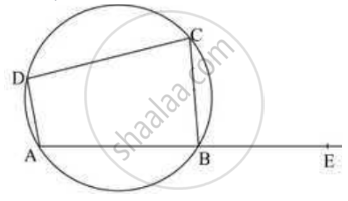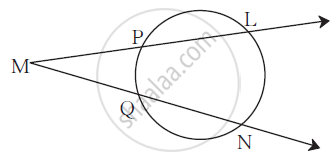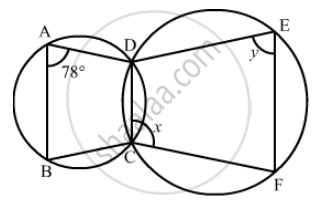Advertisements
Advertisements
Question
ABCD is a cyclic quadrilateral. M (arc ABC) = 230°. Find ∠ABC, ∠CDA, and ∠CBE.

Solution

M(arc ABC) = 230°
M(arc ADC) = 360° - M(arc ABC) … complete circle is 360°
M(arc ADC) = 360° - 230° = 130°
∴ ∠AOC = 130°
The angle subtended by an arc at the point on a circle is equal to half of the angle subtended by the same arc at the center
Here arc ADC subtends ∠AOC at center and ∠ABC on a circle
∴ ∠ABC = (1/2) × ∠AOC
= 1/2 × 130°
= 65°
∴ ∠ABC = 65°
∠ABC + ∠CBE = 180° …linear pair of angles
∴ 65° + ∠CBE = 180°
∴ ∠CBE = 180° - 65° = 115°
∴ ∠CBE = 115°
∠CDA + ∠ABC = 180° …opposite pair of cyclic quadrilateral ABCD
∴ ∠CDA + 65° = 180°
∴ ∠CDA = 180° - 65° = 115°
∴ ∠CDA = 115°
Hence ∠ABC = 65°, ∠CDA = 115° and ∠CBE = 115°
APPEARS IN
RELATED QUESTIONS
Prove that "Opposite angles of a cyclic quadrilateral are supplementary".
If diagonals of a cyclic quadrilateral are diameters of the circle through the vertices of the quadrilateral, prove that it is a rectangle.
If circles are drawn taking two sides of a triangle as diameters, prove that the point of intersection of these circles lie on the third side.
Prove that the circle drawn with any side of a rhombus as diameter passes through the point of intersection of its diagonals.
ABCD is a parallelogram. The circle through A, B and C intersect CD (produced if necessary) at E. Prove that AE = AD.
In any triangle ABC, if the angle bisector of ∠A and perpendicular bisector of BC intersect, prove that they intersect on the circumcircle of the triangle ABC.

In the figure m(arc LN) = 110°,
m(arc PQ) = 50° then complete the following activity to find ∠LMN.
∠ LMN = `1/2` [m(arc LN) - _______]
∴ ∠ LMN = `1/2` [_________ - 50°]
∴ ∠ LMN = `1/2` × _________
∴ ∠ LMN = __________
In the given figure, ∠BAD = 78°, ∠DCF = x° and ∠DEF = y°. Find the values of x and y.

In a cyclic quadrilateral ABCD, if ∠A − ∠C = 60°, prove that the smaller of two is 60°
If the two sides of a pair of opposite sides of a cyclic quadrilateral are equal, prove that its diagonals are equal.
Circles are described on the sides of a triangle as diameters. Prove that the circles on any two sides intersect each other on the third side (or third side produced).
Prove that the perpendicular bisectors of the sides of a cyclic quadrilateral are concurrent.
In the given figure, ABCD is a cyclic quadrilateral in which ∠BAD = 75°, ∠ABD = 58° and ∠ADC = 77°, AC and BD intersect at P. Then, find ∠DPC.

ABCD is a cyclic quadrilateral such that ∠ADB = 30° and ∠DCA = 80°, then ∠DAB =
ABCD is a cyclic quadrilateral such that ∠A = 90°, ∠B = 70°, ∠C = 95° and ∠D = 105°.
If non-parallel sides of a trapezium are equal, prove that it is cyclic.
If P, Q and R are the mid-points of the sides BC, CA and AB of a triangle and AD is the perpendicular from A on BC, prove that P, Q, R and D are concyclic.
